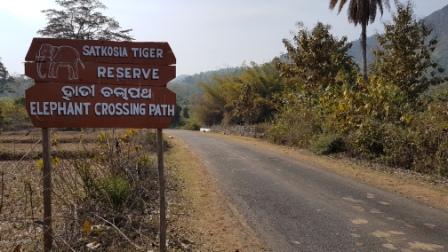The project, Satkosia Sands Resort and Nature Camp, with nine tents on sandbar of Mahanadi and seven cottages on the mountain slope is situated overlooking the mighty Satkosia gorge.
- The revenue in Badmul rose from Rs 27 lakhs in 2016-17 to Rs 60 lakhs in 2017-18 and touched Rs 1 crore 30 thousand in 2018-19 with 3,000 odd visitors
- The nature camp is managed by 28 villagers of Badmul and about five to six villages are earning their livelihood from this project
- Each family managing the project has earned around Rs 1.5-2 lakh this year against Rs 20,000 yearly income prior to this project
Bhubaneswar: Odisha no doubt is a hidden treasure on earth and Badmul Ecotourism has turned to be one of the best kept secrets of Odisha. Earlier Nayagarh district was only known for temples, a little was ever known about the remote forest village Badmul in Satkosia Tiger Reserve in the same district.
It was only in 2016 that the Forest department started an Ecotourism project at this village which lies on the bank of river Mahanadi in Nayagarh district as a community based nature tourism destination.
The project named as Satkosia Sands Resort and Nature Camp with nine tents on sandbar of Mahanadi and seven cottages on the mountain slope is situated overlooking the mighty Satkosia gorge. From revenue of Rs 27 lakhs in 2016-17, Rs 60 lakhs in 2017-18 it touched soaring heights of Rs 1 crore 30 thousand in 2018-19 with 3,000 odd visitors; 20% of them from Germany, France and Britain. From ecotourism to wildlife conservation here are model villages of Odisha that have become shining examples of what community can do for a better future. For the first time in history any village could have earned such an amount from any kind of community projects. The success story also speaks about the secret treasures of state and the potential Odisha carries for sustainable ecotourism with landscapes like Similipal, Satkosia, Bhitarkanika, Chilika, Phulbani and Koraput. Presently, 40 community managed nature camps are functioning spreading all across the state occupying different areas with different biological importance.
Talking about the success of Badmul ecotourism, the divisional forest officer (DFO) said, “This financial year, Odisha ecotourism projects have earned a total revenue of Rs 5.6 crore till date by giving employment to more than 1,000 forest dependent villagers. Satkosia Sands not only served as a livelihood option for the forest dependent communities of southern part of Satkosia but it has also been able to build a stride of confidence among the tribal population and rural women.”
The nature camp is managed by 28 villagers of Badmul (Bethiasahi) and about five to six villages are earning their livelihood from this single project. Earlier, majority of the men from Badmul village used to migrate outside or depend on the forest produce for their livelihood support including poaching and selling of meat of wild animals. Poverty driven poaching in wildlife areas has often been the leading reason for low prey base ultimately leading to decline in carnivore’s population too.
This is why Satkosia Sands at Badmul is not only a success story of nature tourism but also a conservation success story. The landscape has been free from forest fire and poaching since last three years. Each family managing the project has earned around Rs 1.5-2 lakh this year against Rs 20,000 yearly income prior to this project. The nature camp also runs a programme ‘Poachers turned Protectors of Satkosia’ where tourists can interact with the poachers who have been rehabilitated by the Forest department.
NIDHI SINHA
